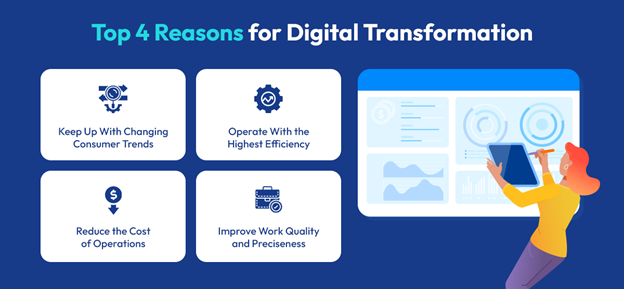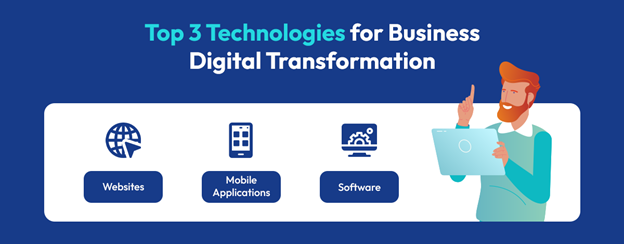#7-step Guide to Crafting a Foolproof Digital Transformation Strategy

Table of Contents
Wondering what is a good digital transformation strategy and how to craft one? Read this blog and get a complete answer to your questions.
Digital transformation is the talk of the town and a business trend. While some businesses have transformed digitally long back, many are still in the process of doing so or are planning their transformation strategy.
Nevertheless, digital transformation has impacted numerous industries and the businesses operating in them and has changed the way in which the consumers of these industries receive their offerings. Be it retail and manufacturing or healthcare and education, every industry and sector has transformed digitally recently in one way or the other.
The recent pandemic further boosted this transformation process and compelled numerous institutions to go digital in order to survive during the lockdown period. This proves that digital transformation is the driving force of the future and is essential for businesses in the long term.
If you are also a business owner planning to transform your business digitally, the first thing you need to do is have a digital transformation strategy in place. However, many business owners are clueless when it comes to curating a digital transformation strategy. Worry not; this blog will provide detailed information on the process for easy understanding.
However, before actually formulating a digital transformation strategy, you must know that transforming digitally is not easy for numerous businesses, as the process requires extensive planning and time & capital investment. Therefore, you must be wondering why businesses undertake digital transformation, right? Let’s start the blog by understanding the core advantages of business digital transformation.
Why Are Businesses Transforming Digitally?

The market size of digital transformation is valued at USD 594.5 billion, with the amount expected to cross 1500 billion by the end of 2027. Today, businesses of all scales and sizes are going digital and are investing in integrating technology into their operations. Here are a few factors that make digital transformation a promising investment.
Keep Up With Changing Consumer Trends
Consumer trends are always changing and evolving. Businesses that aim to stay profitable and competitive must keep up with these consumer trends. This is because present-day consumers are quick to abandon a brand that fails to keep up with the latest market demands.
Digital transformation is the best example in this context. One of the primary reasons why organizations undertake digital transformation is to ensure that they stay in business and are favored by consumers. This is because the latest consumer trend is to do things digitally, be it shopping for goods, availing certain services, or even doing everyday things.
Owing to this factor, numerous traditional businesses have transformed digitally and have started selling their offerings (goods and services) through digital channels This has also enabled these businesses to increase their sales, target a wider customer market, and boost their revenue.
Therefore, by undertaking digital transformation, you are not only likely to keep up with the latest customer trends but can also increase your profitability and sustain your business.
Operate With the Highest Efficiency
It cannot be denied that high efficiency is the key to business success. The more efficient a business’s practices, processes, and operations are, the more likely a business is to gain market success. However, this objective is often hard and usually impossible to achieve with conventional business practices.
To explain, numerous business processes are often time and labor-consuming, making it challenging for businesses to achieve efficiency. Some examples of such processes are inventory management, bookkeeping, employee performance management, etc.
On the other hand, by transforming your business digitally and integrating tech-based solutions in your operations, you are likely to optimize your processes and increase your business’s overall efficiency. This is due to the process automation aspect of technology, which makes businesses self-sustained and reduces the requirement of manual efforts.
Reduce the Cost of Operations
One of the major challenges that most businesses face at present is the increasing cost of operations. Due to the increasing inflation and globally rising economic crisis, it is becoming more and more challenging for organizations to control their costs and remain profitable.
This has been especially the case in recent times when the global economy went into recession with the worldwide COVID outbreak. As a result, numerous businesses have gone bankrupt, while others are struggling to barely survive. In this situation, digital transformation is a billion-dollar idea for controlling the costs of operations.
To elaborate, modern-day technology is highly smart and efficient and is capable of making business organizations self-sufficient. This factor enables businesses to cut down on their processes, reduce human resource requirements, eliminate the least productive processes, and therefore control their overall costs.
Improve Work Quality and Preciseness
Along with controlling costs and conducting processes efficiently, every business also aspires to conduct operations as swiftly as possible. This also includes conducting processes with great preciseness and accuracy, as this is the only way to ensure the optimum quality and the result’s reliability.
However, it is commonly known that the results derived from manually conducted processes are far from being precise and reliable. This is because there is a great chance of human error, which, in many cases, can result in tremendous business losses.
To elaborate, a minor error in the accounting process or inventory management process can result in great deviations, which can potentially cause business failure. However, this is not the case with digitally conducted processes.
This aspect of digital transformation has enabled businesses to conduct processes with zero human effort and no risk of errors. This is because, unlike manually conducted processes, machine-conducted processes are highly reliable and have no chance of going wrong.
This was it for the reason why businesses around the world are undertaking digital transformation. If you are convinced to digitalize your business, keep on reading, as in the next section, we will discuss the fundamentals of digital transformation strategies.
Fundamentals of Strategizing Digital Transformation
Most businesses consider digital transformation as a mere process of developing new technology and integrating it into their operations. While this might sum up the purpose of digital transformation, there is a lot more to it.
Having a well-planned and thoroughly researched digital transformation strategy is essential for every business planning digitalization. These strategies help businesses ensure that their digitalization plan is not only infallible but also suitable for their business requirements and aligns with their objectives.
As a result, a business planning digital transformation needs to consider numerous internal and external organizational aspects before actually crafting a strategy. This ensures that you craft a detailed plan for your business’s digital transformation that is laid on the grounds of successful and time-tested experiences.
Now that you know why it is important to have a digital transformation strategy in place before executing your digitalization plan, let’s find out how to craft a success-guaranteeing strategy.
7-step Process of Building a Foolproof Digital Transformation Strategy

Step 1: Define Digitalization Objectives
Many businesses planning to go digital face tremendous failure, primarily because they overlook the importance of determining the objectives of digitalization. However, let us tell you that this is one of the most crucial steps and serves as the founding stone of further digital transformation.
Here, you have to list down all the areas of business that you want to digitalize, along with why their digitalization can be beneficial for your business.
By determining why exactly you want to digitalize, you can calculate the scope and potential of digital technologies in your organization. This scope will enable you to narrow down the possibilities and find the best possible technology options for your digital transformation plan.
Step 2: Brace for Cultural Changes
While it is the top-level management of a business that plans and executes the digitalization strategy, it cannot be denied that the most significant impact of this transformation is on the lower-most part of the organization’s hierarchy.
As a result, it is only natural for a business undertaking digital transformation to face pushback and resistance from employees. Therefore, a business must remain braced for cultural changes in the organization in order to ensure a smooth and hassle-free transition.
This also includes discussing the digital transformation plan with the entire team of the organization and providing training and development session to the employees to level up their skills and make them familiar with the technology that you plan to integrate.
Step 3: Determine the Scale of Transformation
Digital transformation is a wide concept, and the range and extent to which a business transforms digitally highly varies. To elaborate, while for some businesses, integrating technology in a single function or process is digital transformation, for others, it means undergoing complete digitalization.
Therefore, you need to calculate the scope up to which you want to digitally transform your organization. The best practice here is to undertake slow but well-managed digital transformation for the best results.
This is because rapid digitalization can result in numerous operations hurdles, as it takes time for an organization and its employees to get used to the new processes. Therefore, you must rule out the processes and operations that you want to transform digitally beforehand.
Step 4: Rule Out Technologies
Based on the determined scope, you can determine the technologies that will be the best fit for your requirements. There are numerous technologies to choose from when it comes to digital transformation, and therefore there is no ‘one solution fits all’ answer to this step.
Later in this blog, we have discussed the top technologies that businesses use for digital transformation. You can either go with these popular technologies or even choose different ones, all of which depend upon your business’s requirements.
Usually, businesses use a combination of different technologies to transform digitally to gain maximum benefits from their investment. This includes using high-end technologies like AI, cloud computing, blockchain, AR/VR, and more.
Step 5: Appoint a Partner for Digitalization
Once you have selected the technologies that you want to utilize for your business’s digital transformation, it is time to find an appropriate development partner for your project. This development partner is the one who will be undertaking your digital product’s design and development on your behalf.
Most businesses hire a development outsourcing agency for this purpose. These agencies offer custom and readymade solutions that enable businesses to undertake seamless digital transformation.
Hiring a development agency ensures that you receive high-quality digital solutions that are crafted with well-conducted market research and planning. Moreover, most development agencies also undertake QA engineering, further optimizing the quality of your product.
Step 6: Collect Feedback and Improvise
Once you have completed the digital transformation process, you can go ahead and review the performance of your organization. This will enable you to understand the extent to which digital transformation has benefitted your organization.
This includes collecting feedback from the employees and comparing the expected performance with the actual performance. Based on this review, you can improvise and change your strategies to fit your business’s requirements.
Step 7: Scale and Grow
Based on the conclusions of the previous steps, you can scale your business’s digital transformation. To elaborate, the conclusions from the performance review will help you determine whether or not digitalization has benefitted your organization.
Based on these calculations, you can make decisions on further digitalizing your operations or reducing the scope of digital technologies in your business. This will ensure that digital transformation is not harming your organization and is in alignment with your growth objectives.
In case you find that digital transformation is yielding the desired results, you can go ahead and digitalize more operations and processes.
These were the steps to undertake error-free digitalization. Moving further, let’s find out which technologies a business can use for digital transformation.
Popular Technologies for Digital Transformation

Websites
Websites are one of the oldest digital technologies and are popular to this day. These platforms have been commonly used by businesses for decades as a primary mode of digital transformation.
To elaborate, websites not only enable businesses to create a primary digital identity but are also useful when it comes to offering goods (eCommerce) and services (on-demand services) online.
Today, most businesses, from startups to enterprises and MNCs, are investing in web development. Moreover, it is important to note that investing in web development also enables businesses to seamlessly market themself. This is possible through search engine optimization (SEO), a popular digital marketing strategy.
In addition, websites are relatively easy to create and take less time and capital investment when compared to other popular digital transformation technologies. This makes them one of the most widely chosen digitalization platforms across the globe.
Mobile Applications
Mobile applications are modern, user-friendly, fast-performing, and highly technologically advanced platforms that have become the face of digital transformation. These platforms enable businesses to create online selling mediums, manage business operations, and implement numerous innovative business ideas.
Today, you can build a mobile app for almost anything and everything. Businesses usually utilize this technology for processes like HR management, finance management, inventory management, and more.
It is worth noting that the initial capital and time it takes to develop an app might turn out to be high. However, this technology has great ROI, and you are likely to experience tremendous benefits from building a business mobile application. Therefore, it is in your business’s best interest to consider this option and plan your digital transformation accordingly.
Software
Softwares are complex systems programmed to conduct numerous simple and high-level functions. Today, there is a software for almost anything and everything that a business can look for, from finance management to CRM and even HR management.
Moreover, numerous IT companies also offer niche-specific software solutions, such as:
- Fleet management software for logistics businesses
- Property management systems (PMS) for hotels
- Banking and accounting software for Banks
- Online learning software for schools and universities
- Patient management software for Hospitals and Clinics; and more.
Overall, software are highly useful for efficiently digitalizing a part of your operations or all of your business altogether. You can either go for custom software development for your specific requirements or can even purchase readymade software (Whitelabel software). Either way, you are guaranteed to gain tremendous benefits from this technology.
Summing It Up
Digital transformation is one of the most popular business trends at present. Today, more and more businesses are transforming digitally and are taking their operations online.
However, in order to gain maximum benefits from digital transformation, it is essential for a business to have a well-planned digital transformation strategy ready. This requires following certain steps and processes.
By following the information given in the blog and taking note of the steps to craft a digital transformation strategy, you can create a failproof plan for your business and benefit from digital technology.
by Aakash Soni
If you liked the article, do not forget to share it with your friends. Follow us on Google News too, click on the star and choose us from your favorites.
For forums sites go to Forum.BuradaBiliyorum.Com
If you want to read more like this article, you can visit our Technology category.




